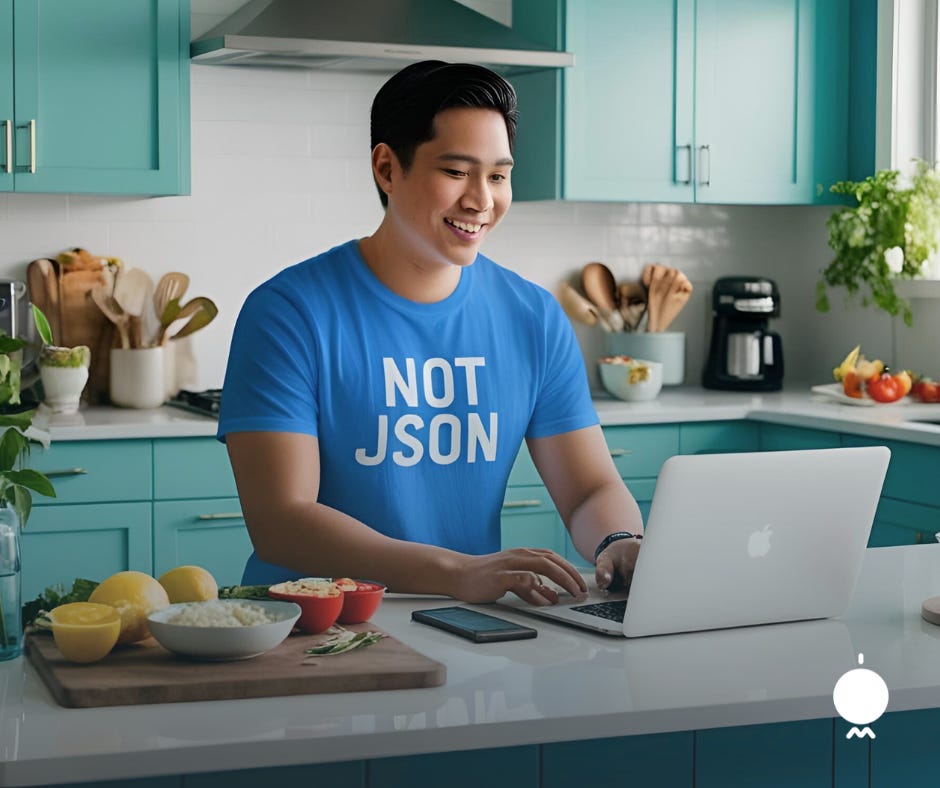Who's JSON and why are they all up in my recipes?
Why your content needs structure and what Jason (and JSON) can teach us about making recipes work everywhere. Plus, a podcast preview.
Let’s talk about JSON, no, not a guy, a format (pronounced "JAY-sahn" or "JASON").
And why it’s one of the most underrated tools in your food content toolkit.
You’ve heard of metadata: cook time, ingredients, categories. They are the hidden details that make your recipe show up on Google, work in apps, or get picked up by platforms. JSON is the structure that holds all of that together.
Think of it like a recipe box for the internet. One that’s readable not just by people, but by search engines, smart kitchen devices, and licensing teams.
That’s the theme of this week’s newsletter: how to build workflows that protect your voice, not dilute it.
Start with this blog post: How structured content drives recipe discoverability and monetization. If your content has ever felt stuck in one place or like you’re doing everything manually, this post is for you.
And if you’re a paid subscriber, you’ll also get access to:
A structured recipe backup template (in JSON!)
A walkthrough on how to future-proof your content library
Tools to help you pitch platforms and protect your work
Upgrade to paid to unlock it all, because your content is too valuable to leave unstructured.
Meet Jason (not JSON): The missing piece wasn't flavor, it was structure
Jason’s been food blogging for a while now. And no, he’s not JSON, though his content could really use them. His audience knows him for bold flavors, clever spins on traditional dishes, and the way he brings culture into every recipe post.

He recently landed a big opportunity: a platform was launching a smart kitchen integration, and he was looking for diverse, high-quality recipe content.
They reached out to Jason. Asked to review his recipe catalog. Things were looking good, until they weren’t.
"We love your style," the team told him, "but your recipes don’t have the structure we need to integrate."
Jason blinked. "The what now?"
His recipes were 🔥, but his metadata? Nowhere to be found.
No cook times separated from the instructions
No clearly defined ingredient fields
No recipe category, cuisine tags, or diet info
No structured formatting that machines (and platforms) could parse. That’s just a techy way of saying "understand and use"
He wasn’t missing creativity, he was missing the content backbone that would make his recipes portable, readable, and monetizable outside his blog.
Jason isn’t alone.
Metadata sounds technical. Boring, even. But it’s what makes your recipe discoverable on Google, usable in food apps, and ready to be licensed by a partner.
Without it? Your content is just a beautiful block of text. Hard to reuse. Hard to sell.
If you’ve ever thought, “I’ve done the hard part already so why isn’t it working?” Metadata might be the answer.
Start here: Metadata 101: The essential recipe data you're probably overlooking
Paid subscribers also get access to a plain-language glossary of food tech terms, so you can decode the jargon while you upgrade your content.
Your Friend in Food: A new way to connect
The trailer for my new podcast just launched! You're getting the first deep dive into what it's about and why it matters.
After years of working with food creators, one thing kept coming up:
We need more space to talk about this.
So I made one.
Introducing: Your Friend in Food — a new monthly (for now!) podcast about the stories behind the recipes and the people who carry them.
It’s cozy, personal, and story-driven. Not about trends or traffic, but about the quiet, powerful ways food content shapes our lives.
You can listen to the trailer now on Apple Podcasts, Spotify, YouTube Podcasts, Audible, and Goodpods.
Check out the video trailer!
Thanks for being part of this community. Whether you’re reading, listening, or building something of your own, I’m glad you’re here.
Your friend in food,
Sandie


